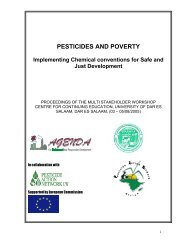Your Daily Poison - Pesticide Action Network UK
Your Daily Poison - Pesticide Action Network UK
Your Daily Poison - Pesticide Action Network UK
Create successful ePaper yourself
Turn your PDF publications into a flip-book with our unique Google optimized e-Paper software.
Hazard to health issues<br />
World Health Organisation classifications<br />
Class LD 50 for the rat (mg/kg body weight)<br />
38<br />
Solids {Oral} Liquids Solids {Dermal} Liquids<br />
Ia Extremely hazardous 5 or less 20 or less 10 or less 40 or less<br />
Ib Highly hazardous 5-50 20-200 10-100 40-400<br />
II Moderately hazardous 50-500 200-2000 100-1000 400-4000<br />
III Slightly hazardous Over 500 Over 2000 Over 1000 Over 4000<br />
U Unlikely to present acute hazard in normal use: ‘WHO Table 5’<br />
O Active ingredients believed to be obsolete or discontinued for use as pesticides<br />
The terms ‘solid’ and ‘liquids’ refer to the physical state of the active ingredient.<br />
The LD50 value is a statistical estimate of the number of mg of toxicant per kg of<br />
bodyweight required to kill 50% of a large population of test animals.<br />
Endocrine disrupting chemicals<br />
<strong>UK</strong> EA – on the <strong>UK</strong> Environment Agency’s list of target<br />
EDCs,<br />
Strategy for Endocrine disrupting chemicals,<br />
http://www.environmentagency.gov.uk/commondata/105385/139909<br />
DEFRA – identified as associated with endocrine<br />
disruption by the <strong>UK</strong> Department for Environment, Food<br />
and Rural Affairs, web site: Hormone Disrupting<br />
Substances in the Environment<br />
http://www.defra.gov.uk/environment/hormone/<br />
index.htm<br />
Definitions of cancer categories<br />
US Environmental Protection Agency<br />
The US EPA has changed its classification systems in<br />
recent years. Some categories have similar definitions:<br />
Weight-of-evidence categories developed during<br />
the 1980s<br />
Group B = Probable Human Carcinogen: B1 indicates<br />
limited human evidence; B2 indicates<br />
sufficient evidence in animals and inadequate or no<br />
evidence in humans.<br />
Group C = Possible Human Carcinogen:<br />
Weight-of-evidence categories developed during<br />
the 1990s<br />
Known/Likely available tumour effects and other key data<br />
are adequate to demonstrate convincingly a carcinogenic<br />
potential for humans.<br />
L1 = Likely at high doses but Not Likely at low doses<br />
L2 = Likely to be carcinogenic to humans, available<br />
tumour effects and other key data are adequate to<br />
demonstrate carcinogenic potential for humans.<br />
S = Cannot be Determined-Suggestive evidence from<br />
human or animal data is suggestive of carcinogenicity,<br />
but is not sufficient to conclude as to human carcinogenic<br />
potential.<br />
Source: Office of <strong>Pesticide</strong> Programs List of Chemicals<br />
Evaluated for Carcinogenic Potential, US EPA, [see details<br />
at www.epa.gov/pesticides/carlist/ although list not<br />
available on website], August 2000.<br />
Ger.EA – potential and confirmed EDCs by the German<br />
Federal Environment Agency column, <strong>Pesticide</strong>s<br />
suspected of endocrine-disrupting effects by Germany’s<br />
Federal Environment Agency, ENDS Report 290, March<br />
1999.<br />
EU – considered as high concern EDC by the European<br />
Union, Commission moots priority list of endocrine<br />
chemicals, BKH/TNO report, June 2000.<br />
OSPAR – identified as a potential EDC under Oslo and<br />
Paris Commission, Endocrine disrupting pesticide:<br />
Gwynne Lyons. <strong>Pesticide</strong>s News 46, December 1999.<br />
European Union<br />
There is no single EU list available denoting carcinogenic<br />
pesticides. EC Directive 67/548 and subsequent<br />
amendments provide the classification of dangerous<br />
substances, including pesticides. The cancer<br />
classifications are:<br />
Category 2 (denoted as R45 on the pesticide label) =<br />
May Cause Cancer<br />
Category 3 (denoted as R40 on label) = Possible Risk of<br />
Irreversible Effects (Cancer, as cited in table)<br />
Sources: EC Directive 67/548 EEC and subsequent<br />
amendments; Chemicals (Hazard Information and<br />
Packaging for Supply) [CHIP2] Regulations 1994, Health<br />
and Safety Executive, <strong>UK</strong>.<br />
International Agency for Research on<br />
Cancer<br />
Group 1 = Carcinogenic to Humans<br />
Group 2A = Probably Carcinogenic to Humans (limited<br />
evidence of carcinogenicity in humans and sufficient<br />
evidence in experimental animals).<br />
Group 2B = Possibly Carcinogenic to Humans (limited<br />
evidence of carcinogenicity in humans and less than<br />
sufficient evidence in experimental animals).<br />
Source: http://193.51.164.11/monoeval/grlist.html<br />
[Note: lists cited include many non-pesticides]<br />
<strong>Your</strong> daily poison:

















